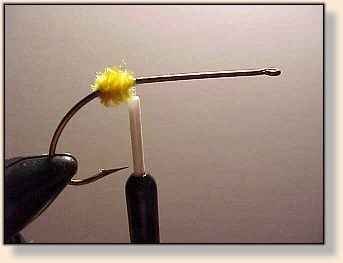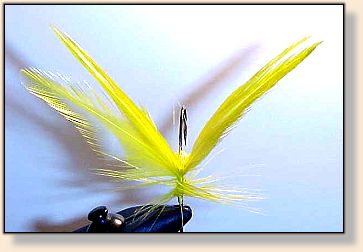A few weeks back there was a post to the Bulletin Board inquiring about how to splay
hackle so that it was actually splayed. So, over the next several weeks we will give you
a few tips on working with and actually taming hackles.
Any of you who tie poppers and deer hair bugs, not to mention Tarpon flies know the
frustration of splaying the tail hackles.

There are two tricks to doing this easily.
The first is to take all thread wraps over the flue of the feather, not over the quills. The quill is
round and even if you flatten it, which is an extra step, it can still twist on the hook shank. The
second part of the trick is to tie in a small ball of chenille where you will be tying in the tails.
OK, let's do it.
Place your hook into the vise. Tie on your thread at the point/barb area. Strip a piece of chenille
of the desired color of about ¼" or so of fluff, and tie it in by the bare thread. Take several wraps
around the hook building up a neat ball at the Hackle tie in point. The ball should be about three
hook diameters for a really good splay.

Next take three or four strung hackles, depending on quality, and match the concave sides so that
they nest like spoons, ends even. If there are separations between the feathers don't worry as long
as the quills are in line. When wet the feathers will tend to come together in a nice group naturally.
Now strip the fluff from the base of all of the feathers at once so that you are into the stiffer webby
section of all of the feathers, including the shortest.
Now, you can clip off the bare quills first, or you can trim them later. If you leave them on, just be
sure not to actually tie in by them. They can and may very well twist on the shank. The quills in the
feather should be about in line with the hook shank so that you have a basic straight line from
eye to the tip of the tails.
Tie in the near side first, just catching the web with the first wraps loosely and taking a few tighter
wraps when you are satisfied with their position. You can now tie in the hackles on the far side
of the hook using the same technique.

After you have the feathers on the hook on both sides, make any final adjustments you want and
take some tight wraps to secure them properly. Place some Daves Fleximent over the tie in point
for a little extra security.
Once your tails are in place you can complete your fly and go fishing. Your tails will now kick like
they are alive in the water, which is exactly what the fish will think they are.
Tight lines, and get kickin' !
If you have any tips or techniques, send them along, most of this
material has been stolen from somebody, might as well steal your ideas
too! ~ George E. Emanuel
(Chat Room Host Muddler)
|







